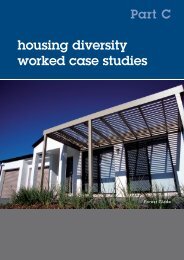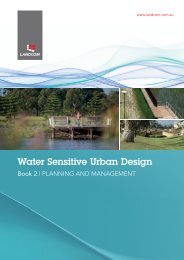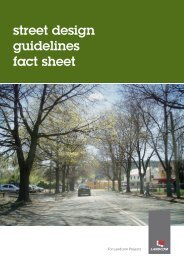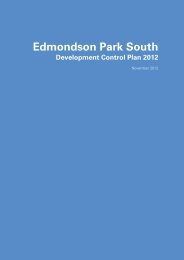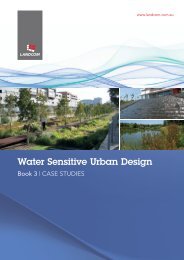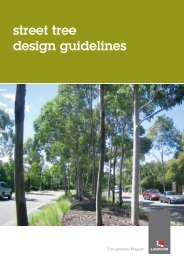Landcom Book 4 Maintenance - WSUD
Landcom Book 4 Maintenance - WSUD
Landcom Book 4 Maintenance - WSUD
Create successful ePaper yourself
Turn your PDF publications into a flip-book with our unique Google optimized e-Paper software.
Water Sensitive Urban Design<br />
What is the Annualised Life<br />
Cycle Cost with respect to<br />
pollutant removal?<br />
The annualised life cycle cost is simply the<br />
Net Present Value (NPV) of the life cycle<br />
cost divided by the life cycle (years) of the<br />
asset.<br />
In developing an example of annualised<br />
life cycle cost, a series of analyses were<br />
undertaken for an asset life cycle period of<br />
50 years. Three different <strong>WSUD</strong> elements<br />
were assessed: bioretention basins,<br />
constructed wetlands, and sedimentation<br />
basins.<br />
Bioretention basins and constructed<br />
wetlands were sized to meet best<br />
management practice pollutant load<br />
reductions for total nitrogen (TN) removal<br />
(that is, 45 percent). The sedimentation<br />
basin was sized to remove 80 percent of<br />
coarse sediment (greater than 125 microns),<br />
while also ensuring the associated clean<br />
out frequency of the basin was a minimum<br />
of 5 years. The life cycle costs are shown in<br />
Figure 1 to Figure 3.<br />
The results are useful in showing the<br />
relative cost of maintenance to upfront<br />
capital cost and in particular the relatively<br />
low cost of maintaining these systems. For<br />
example, the annual maintenance cost of<br />
a bioretention basin sized for a 1 hectare<br />
impervious catchment is approximately 3<br />
percent of the capital cost.<br />
In the life cycle cost figures for each<br />
<strong>WSUD</strong> element (Figure 1 to Figure 3), the<br />
annualised cost in terms of pollutant load<br />
reductions are also reported. Such data is<br />
useful in:<br />
••<br />
assessing the efficiency of one <strong>WSUD</strong><br />
element against another in removing a<br />
specific pollutant<br />
••<br />
comparing the cost of <strong>WSUD</strong> elements<br />
against other pollutant abatement<br />
technology<br />
The annualised cost in terms of pollutant removal for a 1 hectare completely<br />
impervious catchment are:<br />
Bioretention Basin:<br />
− $70 per kg TN removed (45% reduction)<br />
− $320 per kg TP removed (67% reduction)<br />
− $1 per kg TSS removed (81% reduction)<br />
Constructed Wetland:<br />
− $440 per kg TN removed (45% reduction)<br />
− $2,300 per kg TP removed (70% reduction)<br />
− $3 per kg TSS removed (86% reduction)<br />
Sedimentation Basin:<br />
− $500 per kg TN removed (4% reduction)<br />
− $800 per kg TP removed (17% reduction)<br />
− $1 per kg TSS removed (30% reduction)<br />
<strong>Book</strong> 4 | MAINTENANCE 15



